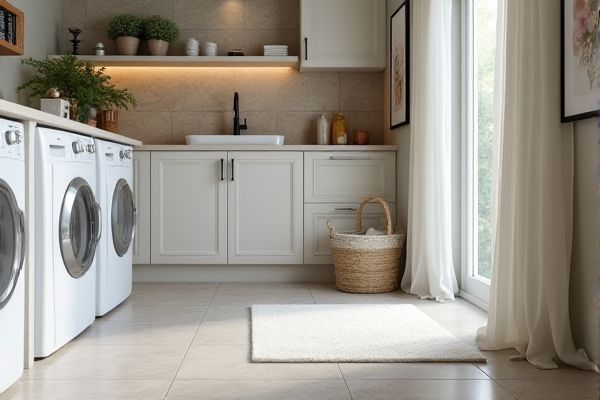
Ceramic tile offers durability and water resistance for laundry floors, while vinyl tile provides affordability and softer comfort underfoot. Explore the pros and cons of each option to determine which flooring best suits your laundry room needs.
Table of Comparison
| Feature | Ceramic Tile | Vinyl Tile |
|---|---|---|
| Durability | Very durable; resistant to scratches and heavy loads | Moderately durable; can dent or scratch under heavy use |
| Water Resistance | Highly water-resistant; ideal for wet laundry areas | Water-resistant but seams may allow moisture penetration |
| Installation | Labor-intensive; requires grout and mortar | Easy DIY installation with adhesive backing |
| Maintenance | Low maintenance; requires regular grout cleaning | Very low maintenance; easy to clean with mild detergent |
| Comfort | Hard and cold underfoot | Softer and warmer than ceramic tile |
| Cost | Higher initial cost | More budget-friendly upfront |
| Appearance | Classic, elegant, wide design options | Versatile designs; can mimic natural materials |
| Longevity | Lasts decades with proper care | May need replacement every 10-20 years |
Introduction to Laundry Room Flooring Options
Ceramic tile offers durability, water resistance, and easy maintenance, making it a top choice for laundry room floors prone to moisture and heavy use. Vinyl tile provides a budget-friendly, softer underfoot option with a wide variety of styles and easy installation, suitable for those seeking comfort and design versatility. Your decision should balance long-term durability with style preferences and flooring budget.
Overview of Ceramic Tile and Vinyl Tile
Ceramic tile, made from natural clay and minerals, offers exceptional durability, water resistance, and a wide range of design options, making it ideal for laundry floors prone to moisture. Vinyl tile provides a cost-effective, softer, and water-resistant alternative with easier installation and maintenance, featuring diverse patterns and textures that mimic natural materials. Both materials are popular for laundry rooms, but ceramic tiles excel in longevity and resistance, while vinyl tiles prioritize comfort and affordability.
Durability: Ceramic Tile vs Vinyl Tile
Ceramic tile offers exceptional durability with high resistance to scratches, stains, and moisture, making it ideal for laundry floors that experience heavy foot traffic and water exposure. Vinyl tile, while less durable than ceramic, provides a softer surface that resists cracking and can withstand moderate wear and tear effectively. Your choice will depend on whether you prioritize long-lasting strength or a more forgiving, flexible floor covering.
Water and Moisture Resistance
Ceramic tile offers superior water and moisture resistance compared to vinyl tile, making it an ideal choice for laundry floors prone to spills and humidity. Its non-porous surface prevents water absorption, reducing the risk of mold and mildew growth. You can rely on ceramic tile to maintain durability and maintain a dry, safe environment in your laundry area.
Ease of Installation and Maintenance
Ceramic tile offers a durable and water-resistant option for laundry floors but requires professional installation due to heavy materials and precise grout application, making it less DIY-friendly. Vinyl tile provides a lightweight, peel-and-stick design that allows for quick and easy installation, ideal for budget-conscious homeowners seeking hassle-free updates. Your choice depends on whether you prioritize long-term durability with higher maintenance like grout cleaning or simple, low-maintenance upkeep with vinyl's water and stain resistance.
Design Variety and Aesthetic Appeal
Ceramic tiles offer a vast design variety with numerous patterns, colors, and textures, providing a timeless and sophisticated aesthetic appeal for laundry floors. Vinyl tiles mimic natural materials like wood and stone, presenting an extensive range of styles with vibrant colors and intricate patterns suitable for modern and casual designs. The choice between ceramic and vinyl impacts the overall ambiance of the laundry space, balancing durability with personalized visual interest.
Comfort and Safety Considerations
Ceramic tile offers a cool and hard surface that can feel uncomfortable underfoot during long laundry sessions, while vinyl tile provides a softer, more cushioned flooring option that reduces fatigue. Vinyl's slip-resistant properties enhance safety by minimizing the risk of falls in a typically wet laundry area, whereas ceramic tile can become slippery when wet unless treated with a textured finish. Choosing vinyl tile for your laundry floor ensures better comfort and safer footing, especially in spaces prone to moisture.
Cost Comparison: Upfront and Long-Term
Ceramic tile typically involves higher upfront costs due to materials and professional installation, averaging $5 to $10 per square foot, whereas vinyl tile ranges from $2 to $5 per square foot with simpler DIY installation. Over time, ceramic tiles offer superior durability and resistance to water and staining, resulting in lower maintenance and replacement expenses compared to vinyl tiles that may require more frequent repairs or replacements, especially in high-moisture laundry areas. Considering long-term value, ceramic tile provides cost-effective performance despite initial investment, while vinyl tile suits budget-conscious projects with shorter lifecycle expectations.
Environmental Impact and Sustainability
Ceramic tile offers greater environmental benefits due to its durability, natural materials, and recyclability, reducing landfill waste over time compared to vinyl tile. Vinyl tiles often contain PVC and other synthetic compounds that release harmful chemicals during production and disposal, contributing to environmental pollution. Sustainable choices in laundry flooring lean toward ceramic for its longer lifespan and minimal ecological footprint.
Choosing the Best Flooring for Your Laundry Room
Ceramic tile offers superior durability and water resistance, making it ideal for laundry floors prone to moisture and heavy foot traffic. Vinyl tile provides a cost-effective, easy-to-install alternative with softer comfort underfoot and excellent stain resistance. Your choice depends on balancing long-term durability with budget and comfort preferences.
 homyna.com
homyna.com